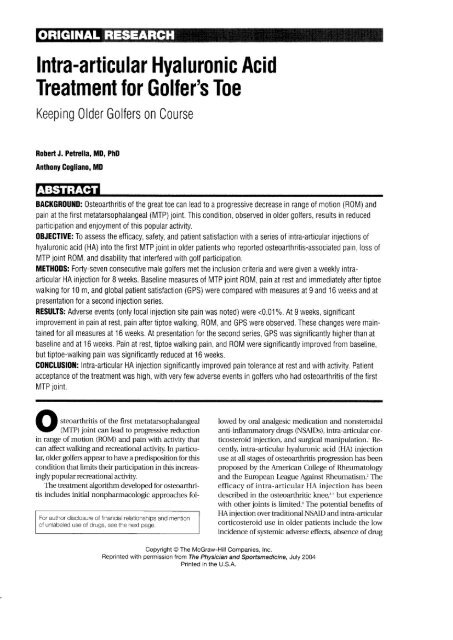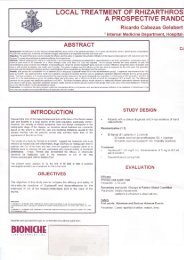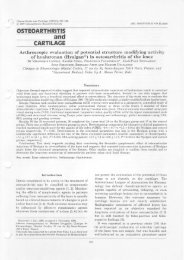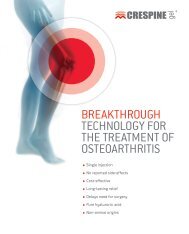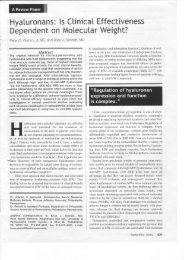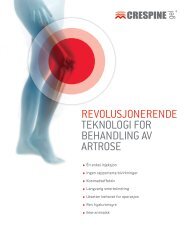Treatment forGolfer's Toe - Crespine Gel
Treatment forGolfer's Toe - Crespine Gel
Treatment forGolfer's Toe - Crespine Gel
You also want an ePaper? Increase the reach of your titles
YUMPU automatically turns print PDFs into web optimized ePapers that Google loves.
I ntra -arti Gu lar Hya I u ron i c Aci d<br />
<strong>Treatment</strong> for Golfer's <strong>Toe</strong><br />
Keeping 0lder Golfers on Course<br />
Robert J. Petrella, MD, PhD<br />
Anthony Cogliano, MD<br />
BAGKGR0UilD: Osteoarthritis of the great toe can lead to a pr0gressive decrease in range of motion (R0M) and<br />
pain at the first metatarsophalangeal (MTP) joint. This condition, observed in older golfers, results in reduced<br />
pafticipation and enjoyment of this popular activity.<br />
0BJECTIVE: To assess the efficacy, safety, and patient satisfaction with a series of intra-arlicular injections of<br />
hyaluronic acid (HA) into the first MTP joint in older patients who repofted osteoarthritis-associated pain, loss of<br />
MTP joint ROM, and disability that interfered with golf participation,<br />
METH0DS: Forty-seven consecutive male golfers methe inclusion criteria and were given a weekly intraafticular<br />
HA injection for B weeks. Baseline measures of MTP joint ROM, pain at rest and immediately after tiptoe<br />
walking for 10 m, and global patient satisfaction (GPS)<br />
'16<br />
were c0mpared with measures at 9 and weeks and at<br />
presentation for a second injection series.<br />
RESULTS: Adverse events (only local injection site pain was noted) were
interaction, and nearly unlimited frequency of use.<br />
Whether intra-articular FIA use in a smaller joint, such<br />
as the first MTB provides efficary and a low side-effect<br />
proflle similar to the knee is unknor,r,.n.<br />
Study Design<br />
The protocol and written informed consent for<br />
studies involving human subjects were approved by<br />
the Universityof Westem Ontario ReviewBoard.<br />
The study was a single-center, single-arm, openlabel<br />
trial with an B-week treatment phase. Within 12<br />
months, orthopedic and primary care physicians referred<br />
patients who had pain in the first MTP joint<br />
(unilateral only) and disability (described as reduced<br />
golfing activity without an acute injury event) for at<br />
least 3 months. In addition, all patients had radiogaphic<br />
evidence of osteoarthritis of the first MTP joint<br />
(ie, grade 1 to 3 hallu rigidus using the Regnauld classification<br />
ofjoint-space narrowing and osteophy'te formation).<br />
The subjects provided informed consent, had<br />
not taken NSAIDs for 2 weeks prior to entry, had not<br />
received intra-articular corticosteroid injection in the<br />
first MTP joint within the previous 3 months, did not<br />
have other lower- extremity musculoskeletal disability<br />
or pain, and had pain exceeding 45 Irrn on a 100-mm<br />
visual analogue scale (VAS) immediately following<br />
tiptoe walking for 10 m.<br />
After screening and enrollment, patients completed<br />
assessments and received a 1.0-mL intra-articular<br />
injecton of FIA (Suplasyn, Bioniche Life Sciences Inc,<br />
Belleville, Ontario; 20 mgl2 mL) in the first MTP joint.<br />
An experienced physician delivered the injections<br />
using a27-gauge needle. The toe was semiflexed and<br />
held in gentle traction without topical or local anesthesia<br />
during injection. One dose was administered each<br />
week (t 2 days) for B consecutive weeks in an unblinded<br />
fashion. Patients returned at 9 and 16 weeks and then<br />
self-selected a follow-up visit when theywould request<br />
a second series of injections based on retum of s1'rnptoms<br />
that interfered with their golf activity.<br />
Assessments<br />
Clinical assessments were performed prior to injection<br />
at baseline, at each of seven subsequent weekly<br />
treatment visits, at 16 weeks, and at the second series<br />
visit (28 to 76 weeks after the eighth injection). Adverse<br />
events were recorded at each srudv visit and classified<br />
using standard World Health O rgarrizatio n terminolo gy<br />
and coding. The primary efficacy measures rvere fust<br />
MTP joint pain after 5 minutes of seated rest and following<br />
completion of 10 m of tiptoe rvalking (assessed<br />
byVAS), range of plantar flexion and dorsiflexion of the<br />
first MTP joint (measured from the metatarsal to the<br />
proximal phalanx with a goniometer), and global<br />
patient satisfaction (GPS)(measured on a S-point categorical<br />
scale, with I representing completeh'unsatisfied<br />
and 5 completely satisfied).<br />
In addition to FIA injection therapv patients were<br />
permitted to use standard nonpharmacologic therapies,<br />
including rest, ice, compression, and elevation,<br />
(RICE) and orthoses, aspirin for cardiovascular disease<br />
prophylaxis up to 325 mg/day, and general analgesia<br />
using acetaminophen up to 1 g/dart NSAIDs were not<br />
allowed during HA treatment but were allowed at<br />
patient discretion during the follow-up posttreatment.<br />
Use of altemate treatment modalities was recorded at<br />
16 weeks and at follow-up visits.<br />
Statistical Analysis<br />
Changes in pain scores were evaluated using analysis<br />
of variance (ANOVA) for repeated measures. GPS<br />
was evaluated to determine the proportion of treatment<br />
responders at each treatment and at follow-up<br />
visits. Frequenry of adverse events over the treatment<br />
period and during follow-up were also recorded. level<br />
of statistical significance was accepted at P
Assessmenl<br />
Age (years)<br />
Male<br />
BMI (kg/m2)<br />
Duration of MTP pain (days)<br />
Used NSAID prior to enrollment<br />
Used NSAID in follow-up<br />
Referrals Screened<br />
(n = 56)<br />
70.5 t 3.1<br />
56 (100%)<br />
27 .1 x 1.4<br />
189.B t23.2<br />
31<br />
Data not collected<br />
Enrolled<br />
(n = 47)<br />
71 t 4.3<br />
47 (100"/,)<br />
26.3 t 1.7<br />
142.6 t28.7<br />
30<br />
6<br />
Severity of pain immediately after walking 10 m on tiptoe (measured on a 100-mm visual analog scale)<br />
Moderate (> 60 mm) 67Yo 66%<br />
Mild (45-60 mm) 32Yo 34Yo<br />
< Mild (< 45 mm) 1o/o \Yo<br />
Osleoarthritis assessment by Regnauld classification<br />
Grade 1 41Yo<br />
Grade 2 40%<br />
Grade 3 19%<br />
Used nonpharmacologic therapies during study (eg, RICE, orlhoses)<br />
Data not collected<br />
36%<br />
42o/o<br />
22o/o<br />
2<br />
BMI = body mass index; MTP = first metatarsophalangealyoint; NSAID = nonsteroidalanti-inflammatory drug; RICE= rest, ice, compression.<br />
and elevation<br />
Results<br />
Fifty-six patients were referred over the study period,<br />
and 47 subjects met entry criteria and provided informed<br />
consent. AII 47 patients completed each<br />
treatment session and reported for follow-up assessments.<br />
All subjects were men, with mean age of 7l (t<br />
4.3) years and a mean body mass index of 26.3 (t 1.7)<br />
kglm2. Osteoarthritis of the fust MTP joint was found<br />
in 37 patients on the right foot and in 11 patients on<br />
the left foot. One patient had bilateral osteoarthritis,<br />
but data from only the left foot were used in the study;<br />
osteoarthritis in the right foot was found incidentally<br />
at the end of the study. Radiographs of the first MTP<br />
joint showed36To had grade l,42Vo had grade 2, and<br />
22To had grade 3 osteoarthritis (Regnauld classification).<br />
Baseline demographic characteristics and additional<br />
therapies used over the treatment phase and<br />
during follow-up were recorded (table l). No significant<br />
difference was observed from prestudy and follow-up<br />
levels of the use of or[hoses, acetaminophen,<br />
orNSAIDs.<br />
E<br />
g<br />
70<br />
6n<br />
LTJ<br />
U)<br />
+<br />
yp30<br />
'6<br />
o-<br />
10<br />
HA <strong>Treatment</strong><br />
0 Baseline g weeks '16 weeks Follow-up<br />
. P
Rest pain (mm).<br />
Tiptoe-walking pain (mm).<br />
Range of motion (degrees)<br />
Increase from baseline<br />
Global patient satisfaction (S-point scale)<br />
Adverse events, pain only<br />
(number of patients)<br />
N/A<br />
Baseline<br />
(n = 47)<br />
41 .2 x 3.1Ï<br />
68.9 t 5.9<br />
6.3 t 4.1<br />
3.1 t 1.3<br />
9Wk<br />
(n = 47)<br />
29.4 t 3.3Ï<br />
40.2 x 4.1+<br />
26.3 t 10.51<br />
16"<br />
4.86 t 0.2<br />
2<br />
16 Wk<br />
(n = 47)<br />
30.4 r 2.9ï<br />
32.8 t 3.1r<br />
32.6 x97t<br />
22"<br />
4.51 t 0,3<br />
0<br />
Follow-up<br />
(n = 47)<br />
26.1 x2.61<br />
59.0 t 18.4S<br />
28.7 t7.51<br />
19"<br />
4.6 t 0.1311<br />
0<br />
.Measured<br />
on a 100-mm visual analoo scale.<br />
ï P
activi$ in addition to standard pain and disability<br />
assessment. " Viscosupplementation with intra- articu -<br />
lar FIA appears to extend pain relief beyond the product's<br />
biological kinetics.'o The structure-modifying<br />
effects (eg, improved chondrocyte density, reduced<br />
synovial inflammation, increased slmovial repair process)<br />
in the osteoarthritic joint may relate to pain<br />
relief,''rz'ts and this is an area of active investigation.<br />
lVhile the evidence regarding viscosupplementation<br />
with FIA in the knee continues to evolve,'limited evidence<br />
and experience existwith other joints, and none,<br />
to ou-r hlowledge, is lcror,rrn in small articular joints. In<br />
two limited studies6''6 in patients who had painful<br />
shoulders, intra-articular FIA injection improved pain<br />
and fr.rnction; therefore, similar efficary in other articular<br />
joints requires ongoing investigation.<br />
Limitations. The present study had several limitations<br />
that could affect the general applicability of the<br />
results. This unblinded, open-label, unrandomized<br />
trial had no active comparator €unong a small number<br />
of otherwise healthy subjects. Future studies should<br />
include larger subject numbers to achieve appropriate<br />
statistical power and use a randomized design that<br />
would include an active comparator treatment arm to<br />
further address efficary and safety.<br />
We used a 1.0-mL HA intra-articular injection administered<br />
once weekly over B consecutive weeks. This<br />
was based on the clinical experience of the primary<br />
investigator with differing volumes and treatment<br />
schedules in this population and was in accordance<br />
with previous weekly treatment schedules for HA in<br />
the knee. Formal dose-response studies would determine<br />
the optimal treatment course for osteoarthritis of<br />
the first MTP joint.<br />
Gonclusions and Recommendations<br />
HA injection produced a significant, long-term<br />
improvement in pain and function in older patients<br />
who had osteoarthritis of the fust MTP joint. Because<br />
of the small articular space, we used 1.0 mL of HA<br />
without any associated local and systemic adverse<br />
events. The regimen used in this study produced high<br />
patient satisfaction, was associated with limited need<br />
for concomitant therapies during follow-up, and<br />
appeared acceptable as a repeated, long-term therapeutic<br />
option. PSM<br />
REFERENCES<br />
l. Creamer Il Hochberg MC: Osteoarthritis. Lancet 1997;350<br />
(9076):503-508<br />
2. Maheu E, Ayral X, Dougados M: A hyaluronan preparation<br />
(500-730 kDa) in the treatment of osteoarthritis: a review of<br />
clinical trials with Hyalgan. Int I Clin Pract 2002;56(10):BOa-<br />
Bt3<br />
3. Petrella RL DiSilvestro MD, Hildebrand C: Effects of hyaluronate<br />
sodium on pain and physical functioning in osteoarthritis<br />
of the knee: a randomized. double-blind.<br />
placebo-controlled clinical trial. Arch Intern Med 2002;162<br />
(3):292-298<br />
4. Frizziero L, Govoni E, Bacchini P: Intra-articlar hyaluronic<br />
acid in tre treatment of osteoarthritis of the knee: clinical<br />
and morphological study. Clin Exp Rheumatol 1998;16(4):<br />
44t-449<br />
5. Altman RD, Moskowitz R: Intraarticular sodium hyaluronate<br />
(Hyalgan) in the treatment of patients with osteoarthritis<br />
of the knee: a randomized clinical trial. Hyalgan<br />
Study Group. I Rheumatol 1998;25(l l):2203-2212<br />
6. Leardini G, Perbellini A, Franceschini M, et al: Intra-articular<br />
injections of hyaluronic acid in the treatment of painful<br />
shoulder. Clin Ther l9BB; 10 (5):521-526<br />
7. Spector TD, Cicuttini E Baker J, et al: Genetic influences on<br />
osteoarthritis in women: a twin study. BMJ 1996;312(7036):<br />
940-943<br />
B. Kujala UM, Kaprio l, Sarna S: Osteoarthritis of weight bearing<br />
joints of lower limbs in former elite male athletes. BMI<br />
i 994 ; 308 (6923):231-234<br />
9. Carrabba M, Paresce E, Angelini M, et al: The safety and<br />
efficacy of different dose schedules of hyaluronic acid in<br />
the treatment of painful osteoarthritis of the knee with<br />
joint effusion. EurJ Rheumatol Inflam 1995;15:25-31<br />
10. \À/hite\Àts,\Mhelton A: Cardiovascular events and COX-2<br />
inhibitors. IAMA 2001;286(22) :2BII -2812<br />
11. Johnson AG, Nguyen Tl Day RO: Do nonsteroidal antiinflammatory<br />
drugs affect blood pressure A meta-analysis.<br />
Ann Intern Med 1994; l2 I (4):289-300<br />
12. ListratV Ayral X, Patarnello E et al: Arthroscopic evaluation<br />
of potential structure modifying activity of hyaluronan<br />
(Hyalgan) in osteoarthritis of the knee. Osteoarthritis Cartilage<br />
1997;5(3) : 153- 160<br />
13. Bellamy N, Kirwan L Boers M, et al: Recommendations for<br />
a core set of outcome measures for future phase III clinical<br />
trials in knee, hip, and hand osteoarthritis: consensus<br />
development at OMERACT IIL I Rheumatol1997;24(4):<br />
799-802<br />
14. Kotz R, Kolarz G: Intra-articular hyaluronic acid: duration<br />
of effect and results of repeated treatment cycles. Am J<br />
Orthop 1999;28(I I suppl):5-7<br />
15. Pasquali Ronchetti I, Guerra D, Tâparelli E et al: Morphological<br />
analysis of knee rynovial membrane biopsies from a<br />
randomized controlled clinical study comparing the effects<br />
of sodium hyaluronate (Hyalgan) and methylprednisolone<br />
acetate (Depomedrol) in osteoarthritis. Rheumatology<br />
(O;dord) 20Ol;40 (2):l5B- I 69<br />
16. Rovetta G, Monteforte P: Intraarticular injection of sodium<br />
hyaluronate plus steroid versus steroid in adhesive capstt-litis<br />
of the shou-lder.Int ITissue React l99B;20(4):125-130<br />
2oNo.7.July2004


